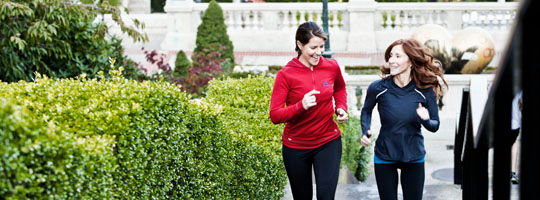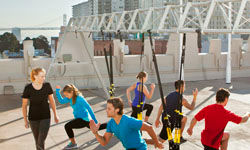
By Carrie Myers
Teaching yoga at Omni Mt. Washington Hotel and Resort provides the perfect backdrop—the Presidential Mountain Range and a beautiful historic hotel—to get all zenned-out. The conservatory, the room I teach in, is surrounded by windows, looking directly out at the mountains. The ceiling is rounded and inverted to provide exceptional acoustics. The fireplace provides wonderful warmth during the colder winter months. As soon as the weather allows, however, classes are moved out to the South Veranda—black flies and all.

Cover Your Bases: Permits and Insurance
Locations vary in whether or not they require permits to teach classes outdoors. Check with your local parks and recreation department or city/town clerk to determine the specific requirements for the space you want to use. If a permit is required, it may or may not cost anything, but most cities/towns will require you to carry liability insurance.
“My boot camp is through the city of Malibu parks and recreation,” says Clayton. “I had to take out an insurance policy for $1,000,000 with the city named as a secondary insured. They offered a couple ways to set up payment—a $60 field use fee or a 70/30 split revenue—and I must have the permit with me during each class.”
“Park management can be pretty strict,” adds Halvorson, “so it’s best to obtain a permit. Unfortunately, in some parks the cost of the permit can have a serious impact on income so be sure to look into your park’s regulations and use fees before committing to a location.”
Some locations may allow you to teach a class without paying for a permit if it is done for free or on a donation basis. “I taught a class with two other instructors at a public beach,” says Gordon, “and they said we only needed a permit if we were going to charge money; if the class was free, we didn't need the permit. That allowed us to make it a donation-only class and successfully get around that situation.”
I was hesitant the first time I decided to take class outdoors. After all, some might not appreciate being out there, communing with the bugs and dirty porch floor. At one point, there was even construction going on, so the noise and fumes sometimes added to the experience. But even with all the potential distractions, I have never received one complaint from participants about being outdoors. Perhaps the incomparable scenery overrides any negatives that come from being outside. Whatever the specific reason, exercising outdoors offers added benefits that indoor exercise simply can’t offer. A review of studies focusing on outdoor exercise concluded that “green exercise”—physical activity in natural areas—decreases the risk of mental illness and improves one’s sense of well-being. In fact, after reviewing data from 1252 participants performing green exercise in 10 studies, researchers found that:
- two out of three participants reported improved self-esteem
- two out of three people reported improved mood
- three out of four people reported feeling less depressed, tense and angry
And it doesn’t take long to gain these benefits. They found that just five minutes a day does the trick.
The review of studies, which was published in Environmental Science & Technology, found that most trials showed an improvement in mental well-being. Compared with exercising indoors, exercising in natural environments was associated with greater feelings of revitalization, increased energy and positive engagement, as well as decreases in tension, confusion, anger and depression. Participants also reported greater enjoyment and satisfaction with outdoor activity and stated that they were more likely to repeat the activity at a later date.
Exercising outdoors can also give you a healthy dose of vitamin D—essential for calcium absorption, strong bones, a resilient immune system and healthy weight maintenance. Overweight individuals tend to have lower amounts of vitamin D in their bodies, partly because excess body fat absorbs and holds onto vitamin D, making it unavailable to the body. The absence of vitamin D creates interference with the functioning of leptin, a hormone that signals to the brain that you are full and should stop eating. Harvard Medical School’s teaching affiliate, Brigham and Woman’s Hospital, states that the best source of vitamin D is from the sun, because vitamin D in this form stays in the body longer with greater lasting benefits. They suggest getting 10 minutes of unprotected sunlight, three times a week.
There’s also the professional and financial benefit of expanding your space outside four walls. “Training people outdoors allows us to maximize our space,” explains Doug Holt, C.S.C.S., M.F.S., owner of Conditioning Specialists in Santa Barbara, Calif., which offers outdoor boot camp, beach workouts, hiking, sports conditioning, triathlon training and outdoor TRX training. “We have a finite amount of indoor square footage to utilize, but [taking classes] outdoors allows us to greatly expand beyond those walls and thus bring in more revenue. Our clients and staff also like the change.”
Interesting Fact: Outdoor activities are in! Each year, more than 170 million people visit national parks and forests for recreation. The physical-activity cost (i.e., calories burned) associated with these visits is equivalent to 290 billion food calories. That equals enough French fries laid end-to-end to reach the moon and back—twice—according to a recent study in the Journal of Forestry.
Teaching outdoors can also make you more visible to potential customers. When Samantha Clayton, an ACE-certified Personal Trainer in Malibu, Calif., taught her boot-camp class outside, she found it was a very effective marketing tool.
“I used this class as a way to attract personal clients for the rest of the year when my class is not available,” says Clayton. “It is a great way to market yourself, being outside where passersby are curious.”
Ryan Halvorson, performance specialist at Bird Rock Fit in San Diego, Calif., agrees. “Non-participants get to observe from a safe distance and might just join up if they like what they see. Be sure to keep business cards on you at all times so you can hand them out to potential clients.”
What Types of Classes Work Outdoors?
A recent trends report ranked outdoor activities 14th out of the top 20 health and fitness trends for the year. With the extra benefits exercising outdoors provides when compared to exercising indoors, you should consider working in some outdoor classes and training sessions into your schedule. Just remember that you don’t have to limit your outdoor classes to boot camp. Here are some creative ideas to help you get started:

Boot camp, of course, is an obvious choice to hold outdoors, but how about a little yoga in natural surroundings? Dashama Konah Gordon, creator of the Pranashama method of yoga, holds classes on beach settings, usually in tropical locations, such as Southern Florida, Mexico and Bali.
“I love to teach outdoors and I love to connect with people through the art and exercise of yoga, meditation and dance,” says Gordon. “People get more out of the experience with my classes by being able to connect with nature and breathe the fresh air and sunshine, which is very essential to experience stress relief and yoga.”
Most of us, however, probably do not have tropical surroundings in which to teach. This doesn’t stop Donna Klimkiewicz, owner of Open Air Yoga in New York City. Klimkiewicz teaches classes at two parks—Battery City Park and Central Park.
Some may feel the distractions you encounter outdoors aren’t conducive to focused yoga practice. Klimkiewicz disagrees. “Taking your practice outside gives you the chance and the challenge to be deliberately present in nature—not the easiest thing to find in frenetic NYC,” she explains on her Web site. “The variables make it even more interesting: a random dog wants to sniff your mat, two ants march past your toes carrying a sliver of leaf, a bird overhead drops droppings an inch away. Maybe a passing tourist wants to stop and watch. Maybe raindrops bless your face just as you lay back for Savasana. It all adds up to another layer of yogic practice: Can you be focused and present in the midst of it all? And conversely, can you embrace the distractions and let them be part of the moment you’re in right now?”
Equipment Needed for Outdoor Yoga: Yoga mats, which participants can bring themselves. Sound system, if desired.

One day, upon arriving to a corporate fitness class I teach, I couldn’t bear the thought of staying inside on one of the first bright, sunny, warm days of the year. I told everyone to grab their exercise tubing and follow me. We walked about half a mile to a field with a boulder; I stood on top while they stood around it and we went through several strength-training exercises using the tubing, as well as the boulder. They performed push-ups and dips off the rock, and held planks on it. We also skipped and performed walking lunges, squats and Indian sprints or intervals to get back to their worksite. This workout became a favorite for days that weren’t too hot or rainy during the warmer months. My participants, many of whom work in cubicles all day long, welcomed the chance to get outdoors mid-day and get some fresh air and sunshine along with their workout.
Equipment Needed for Outdoor Strength Training and Walking: Exercise tubing
“Be creative when designing outdoor classes. People are tired of the same old tired push-up and sit-up routines. Make them an enjoyable experience for your participants. For instance, I like to incorporate plenty of games or challenges so that people work together as a team. This breaks down barriers and makes time fly.”
–Ryan Halvorson

Take your indoor cycling class outdoors. Of course, whether or not this is feasible depends on how close your bikes are to an exit. A deck or patio works best, as you want the ground to be as level as possible so that the bikes aren’t rocking from side-to-side while your participants are pedaling.
Equipment Needed for Cycling: Indoor cycling bikes, sound system (optional)

There are a couple of ways to set up a fitness trail without spending a lot of money. If you have an actual trail available, find spots along the way that have rocks and fallen logs that can be used for push-ups, step-ups, dips, planks and balance beams. Have participants walk or run to each station along the trail. Throw in walking lunges, skipping, squats, bunny hops and grapevines along the way, as well.
This same concept works well in a park, too. Lead your group in a walk or run around the park, stopping at stations along the way, or in between laps around the park. Use park benches, stairs, rocks, railings and even playground equipment to incorporate strength-training exercises between cardio intervals.
Halvorson, who teaches playground and parcourse fitness classes, loves these types of classes, as they force him to become creative by using whatever equipment is provided for him.
“At the end of the day, if you’ve got the know-how, you really don’t need equipment,” he encourages. “My favorite classes are those that require me to creatively use my surroundings. I’ve taught classes for conventions in which my ‘gym’ was the urban landscape. I used stairs, benches and other landmarks. But don’t get caught up on using stairs just for running up and down, or benches to step on. There are lots of different ways to use them and challenge participants both physically and mentally.”
Equipment Need for Fitness Interval Trail/Playground Classes: Only what you find along the way!
___________________________________________________________________
 Carrie Myers is owner of CarrieMichele Fitness and is the author of the award-winning book, Squeezing Your Size 14 Self into a Size 6 World: A Real Woman’s Guide to Food, Fitness, and Self-Acceptance.
Carrie Myers is owner of CarrieMichele Fitness and is the author of the award-winning book, Squeezing Your Size 14 Self into a Size 6 World: A Real Woman’s Guide to Food, Fitness, and Self-Acceptance.